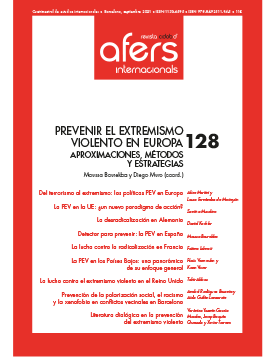Introducción: ¿cambio de paradigma? Del antiterrorismo a la prevención del extremismo violento (PEV)
Resumen
Revista CIDOB d’Afers Internacionals, n. 128
Cuatrimestral (mayo-septiembre 2021)
ISSN:1133-6595 - E-ISSN:2013-035X
DOI: doi.org/10.24241/rcai.2021.128.2
Los gobiernos europeos han tenido que enfrentarse, en los últimos años, con tres retos de seguridad relacionados con la amenaza terrorista presente desde el año 2001: el terrorismo autóctono, el fenómeno de los combatientes extranjeros y el ascenso de la extrema derecha violenta (Mastroe, 2016).
El primero reto se refiere al incremento del terrorismo autóctono de índole yihadista (home-grown terrorism). Si bien algunos ataques terroristas fueron perpetrados por yihadistas en Europa en la década de 1990 (por ejemplo, los atentados cometidos por el Grupo Islámico Armado argelino en Francia en diciembre de 1994 y octubre de 1995), los ataques yihadistas posteriores al 11 de septiembre de 2001 (11-S) son mucho más numerosos y letales, y tienen más ramificaciones fuera del territorio europeo. Según Petter Nesser (2018), cinco elementos explican el incremento de los ataques terroristas yihadistas en Europa: 1) la globalización del yihadismo, sobre todo después de los ataques del 11-S, marcada por los esfuerzos de Al Qaeda para establecer redes yihadistas y de apoyo en Europa; 2) la invasión estadounidense de Irak (2003), que animó a determinados europeos a unirse a la insurrección en Irak o a perpetrar ataques en Europa para provocar la retirada de las tropas europeas en esa región; 3) la descentralización de Al Qaeda, que permitió la posterior emergencia de células terroristas independientes de la sede central de la organización y de lobos solitarios; 4) el uso de las redes sociales para difundir la propaganda yihadista y reclutar de forma masiva, y 5) la guerra en Siria, marcada por una movilización yihadista global sin precedentes (como demuestra, por ejemplo, la proclamación del califato por la organización Estado Islámico). Como consecuencia de ello, entre 2000 y 2018, el terrorismo yihadista se cobró la vida de 1.703 ciudadanos y/o residentes europeos (Pagazaurtundua, 2019), más del 91% de las víctimas de los ataques terroristas perpetrados en suelo europeo durante ese período.
Citas
Aasland Ravndal, Jacob; Thorstensen, Madeleine; Ravik Jupskås, Anders y Macklin, Graham. RTV Trend Report 2021. Right-Wing Terrorism and Violence in Western Europe, 1990 – 2020. Universidad de Oslo, C-REX Research Report n.° 1, (2021) (en línea) https://www.sv.uio.no/c-rex/english/publications/c-rex-reports/2021/rtv-trend-report/c-rex-rtv-trend-report-2021.pdf
Borum, Randy. «Understanding the Terrorist Mind-Set». FBI Law Enforcement Bulletin, vol. 72, n.° 7 (2003), p. 7-10.
Conway, Maura. «Determining the Role of the Internet in Violent Extremism and Terrorism: Six Suggestions for Progressing Research». Studies in Conflict & Terrorism, vol. 40, n.° 1 (2017), p. 77-98.
Europol. European Union Terrorism Situation and Trend Report (TE-SAT) 2020. European Union Agency for Law Enforcement Cooperation, (2020) (en línea) https://www.europol.europa.eu/activities-services/main-reports/european-union-terrorism-situation-and-trend-report-te-sat-2020
Institute for Economics and Peace. Global Terrorism Index 2020. Measuring the impact of terrorism. Institute for Economics & Peace, (noviembre de 2020) (en línea) https://visionofhumanity.org/wp-content/uploads/2020/11/GTI-2020-web-1.pdf
Khalil, James; Horgan, John y Zeuthen, Martine. «The Attitudes-Behaviors Corrective (ABC) Model of Violent Extremism». Terrorism and Political Violence, (2019) (en línea) https://doi.org/10.1080/09546553.2019.1699793
Kundnani, Arun, y Hayes, Ben. The Globalisation of Countering Violent Extremism Policies Undermining Human Rights, Instrumentalising Civil Society. Amsterdam: Transnational Institute, 2018.
Malet, Daniel y Hayes, Rachel. «Foreign Fighter Returnees: An Indefinite Threat?». Terrorism and Political Violence, vol. 32, n.° 8 (2020), p. 1.617-1.635.
Mastroe, Caitlin. «Evaluating CVE: Understanding the Recent Changes to the United Kingdom’s Implementation of Prevent». Perspectives on Terrorism, vol. 10, n.° 2 (2016), p. 50-60.
McCauley, Clark y Moskalenko, Sophia. «Mechanisms of Political Radicalization: Pathways Toward Terrorism». Terrorism and Political Violence, vol. 20, n.° 3 (2008), p. 415-433.
Moghaddam, Fathali. «The Staircase to Terrorism». American Psychologist, vol. 60, n.° 2 (2005), p.161-169.
Nesser, Petter. Islamist Terrorism in Europe. Londres: Hurst Publishers, 2018.
Pagazaurtundua, Maite. Le livre noir et blanc du terrorisme. ALDE y AFVT, (2019) (en línea) http://www.bruxelles2.eu/wp-content/uploads/2019/03/livreblancnoirterrorismefr.pdf
Renard, Thomas y Coolsaet, Rik (eds.). Returnees: Who Are They, Why Are They (not) Coming Back and how Should We Deal with Them? Assessing Policies on Returning Foreign Terrorist Fighters in Belgium, Germany and the Netherlands. Egmont – The Royal Institute for International Relations, Paper 101, (febrero de 2018) (en línea) https://aei.pitt.edu/94367/1/egmont.papers.101_online_v1%2D3.pdf
Romaniuk, Peter. Does CVE Work? Lessons Learned from the Global Effort to Counter Violent Extremism. Goshen: Global Center, 2015.
The Soufan Centre. White Supremacy Extremism: The Transnational Rise of the Violent White Supremacist Movement. The Soufan Group, reporte, (septiembre de 2019) (en línea) https://thesoufancenter.org/research/white-supremacy-extremism-the-transnational-rise-of-the-violent-white-supremacist-movement/
The Soufan Group. Foreign Fighters: An Updated Assessment of the Flow of Foreign Fighters into Syria and Iraq. The Soufan Group, reporte, (diciembre de 2015) (en línea) https://templatelab.com/foreign-fighters-in-syria-update/













